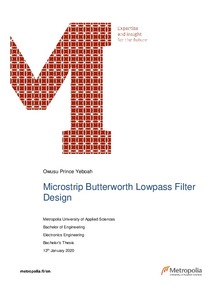Microstrip Butterworth Lowpass Filter Design
Owusu, Prince (2020)
Julkaisun pysyvä osoite on
https://urn.fi/URN:NBN:fi:amk-202001161321
https://urn.fi/URN:NBN:fi:amk-202001161321
Tiivistelmä
Lowpass filters of different kinds are almost ubiquitous in RF and microwave engineering applications. The design of filters, therefore, is crucial in the study of electronics. This thesis aims to explore the design of three different types of Lowpass Butterworth filter namely Lumped element, Stepped Impedance and Stubs designs, and then compare and contrast their various stimulated responses and actual responses.
This paper gives a rather brief but succinct theoretical framework and, where necessary, some historical background to the subjects and focuses more on the design. There is a great amount of literature on the in-depth mathematical and design identities used in this paper. This thesis utilizes the available knowledge for the designs. The filters were designed with specific given parameters employing the NI AWR software for design and simulation. Finally, the designed layouts were printed using a PCB printing machine and analyzed using a network analyzer.
The results obtained weren’t as expected, the Lumped element design produced an unexpected accurate response while the measured response of the other two designs was not the desired results. The cut-off frequency of 1Ghz used was perhaps too low.
This paper gives a rather brief but succinct theoretical framework and, where necessary, some historical background to the subjects and focuses more on the design. There is a great amount of literature on the in-depth mathematical and design identities used in this paper. This thesis utilizes the available knowledge for the designs. The filters were designed with specific given parameters employing the NI AWR software for design and simulation. Finally, the designed layouts were printed using a PCB printing machine and analyzed using a network analyzer.
The results obtained weren’t as expected, the Lumped element design produced an unexpected accurate response while the measured response of the other two designs was not the desired results. The cut-off frequency of 1Ghz used was perhaps too low.
